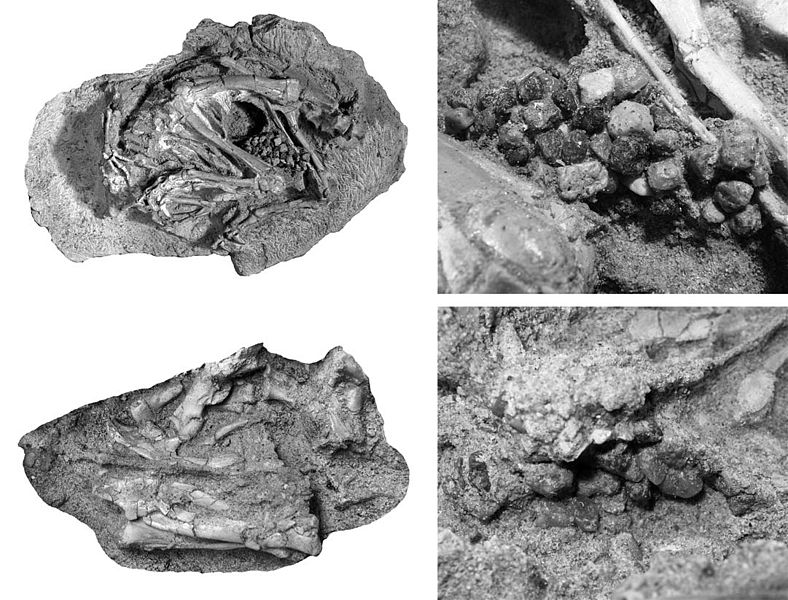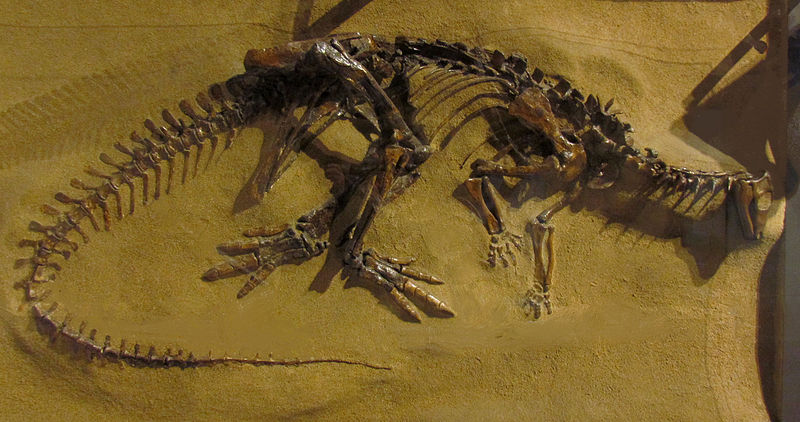 |
| Talenkauen. Gabriel Lio (c) |
It's patently obvious that dinosaur paleontology, like all sciences, does not arrive devoid of cultural trappings and the limitations imposed on it by the socio-political boundaries of the time. One need merely look back a few decades ago when the iconic dinosaur faunas of late Cretaceous Western North America were heralded as the "typical" dinosaur fauna of the time. Fortunately ventures to far flung places around the globe by both western and non-western scientists has increased our knowledge of dinosaur faunas. Because of this more globally conscious awareness of dinosaur faunas it can now be argued that the famed North American fauna of the late Cretaceous, you know the iconic tyrannosaurid-ceratopsid-hadrosaurid triumvirate, is actually a bit of an outlier for the time. In some areas primitive tyrannosaurids held sway while in many areas of Gondwana a rotating cast of abelisaurs, carcharodonotsaurs, unenglianes, spinosaurids, and neovenatorid allosaurids duked it out. Titanosaurid sauropods were ubiquitous in almost all areas as well as dicreasosaurid and rebbachiasaurid sauropods. Nodosaurid ankylosaurs persisted in many areas, even Antarctica. And ornithopods were around too, yeah those boring guys that only drink, nibble and act scared in dinosaur pictures. Ornithopods are at best portrayed as "meals on wheels" for the theropods hordes- movable cannon fodder for the infinitely more interesting predatory dinosaurs. Even among herbivores they take second stage to prickly horned/armored dinos, feathered dinos and massive sauropods. But I want to challenge this idea of boring ornithopods. A steady trickle of discoveries of gondwanan ornithopods has been coming to light for several decades suggesting a previously unheralded diversity of Gondwanan ornithopods. Some types may have been semi-aquatic, some highly cursorial, and others may have been specialized browsers converging with the northern therizinosaurid dinos. And some may have been massive, based on the ichnological (footprint) evidence.
For this post I want to concentrate on Cretaceous ornithopods of South America. Much of the information for this post is taken from the awesome tome The Age of Dinosaurs in South America by Fernando E. Novas. An excellent book by the way full of loads of illustrations, comprehensive but pretty technical- check it out. This is by no means meant to be a comprehensive review of what is known for these guys- I just want to highlight some of the more interesting aspects of these critters that caught my attention.
While South America has gained notoriety in dino circles in recent years for the massive saurischians found there such as Giganotosaurus and Argentinosaurus, it has also become apparent that diverse and sometimes fairly large ornithopods also inhabited the South American land mass during the Cretaceous. So far this data consists of abundant ichnological evidence from multiple localities throughout the epoch and osteological remains from the upper Cretaceous of Patagonia. Although the skeletal remains are limited in scope and abundance, what we do see suggests a unique radiation of southern ornithopods- possibly representing one or more families unique to Gondwana. Recognized by Cambiaso (2007) these derived iguanodontid ornithopods of South America form a clade of the genera Talenkauen, Macrogrhyphosaurus, and Anabisetia - nestled between Muttabaurrasaurs and Camptosaurus. The fourth South American ornithopod known from good remains, Gasparinisaurua, is more basal- nestled between Yandusaurus and Hypsilophodon.
Gasparinisaura cingosaltensis for all intents and purposes looks like a throw-back to the types of ornithopods seen scampering under the feed of massive sauropods in many dinosaur illustrations. And there is some truth to this- as most research points out this species is fairly basal among ornithopods even though it comes from the early late Cretaceous of about 83 mya. Despite its generally conservative design it featured some derived characters, such as a first metatarsal reduced to splint and subtriangular distal caudal chevrons. The second feature is unique among ornithopods, with the exception of Macrogryphosaurus, and is accompanied with a reduction of transverse processes and elongation of the prezygophyses. All together these features are interpreted as adaptations towards extreme cursoriality and converge with tyrannosaurids and ornithomimids (Novas, 2009). Other notable feature of this taxon is large orbits and evidence for gastroliths (see below).
 |
| Gasparinisaura gastrolith. Coria and Salgado. 1996 (c) |
Anabisetia saldiviai from the Nequeun basin, Patagonia-Agentinia is slightly older than Gasparinisaura but more derived and slightly larger at about 2 meters. Known from four partial skeletons Anabisetia, like Gasparinia, shows several obvious adaptations towards a cursorial lifestyle as seen in the skeletal reconstruction towards the left, most notably
the long lower leg bones. The most unique feature of this ornithopods is the well developed acromial process which is taken further than in any other ornithopod. In humans the acromial process is an important site for muscle attachment and, in concert with the trapezius muscle, allow us to raise our arm above our head and pull back. Given that Anabisetia also had grasping fingers, it stands to reason that such shoulder development in this animal possibly assisted it in grasping and bringing down low branches and vegetation. Coupled with the long, gracile neck such an adaptation may have proved useful for a small browser.
Talenkauen santacrucensis was much larger than Gasparinisaura and Anabisetia at about 4 meters. Being substantially larger, this ornithipod starts to show a skeleton more reflective of a graviportal animal- with stouter lower leg bones and thicker femurs than the other smaller ornithopods we discussed. However the neck, forelimbs, and general build suggest an interesting compromise between a robust and gracile animal. One of the more unusual features of this critter are the ovoid bony growths visible between the ribs.
 |
| Talenkauen. Novas 2001 (c) |
Macrogryphosaurus gondwanicus is the largest non-hadrosaurid ornithopod known from skeletal remains in South America. The name means "big enigmatic lizard" and it fits. Unfortunately lacking skull and leg bones the remains indicate a subadult animal at 6 meters longs, so the adult may have been well over 20 feet long. I drew a very liberally interpretive drawing below, however on retrospect I should have given it a smaller head- but like the other ornithopods discussed it was likely an obligate biped with grasping arms/hands and a fairly long neck. More discoveries await. Together with Talenkauen this dinosaur has been proposed to form the clade Elasmaria (Calvo, Novas 2007). It also was found with those interesting quasi uncinate plates on its thoracic areas. Thescelosaurus from North America Maastrichtian is also known for these growths. One is forced to wonder if Thescelosaurus is not actually fairly close/or a member of the Elasmaria and is actually a southern transplant like Alamosaurus? I don't know but it is an interesting idea to explore because at least superficially they look Thescelosaurus looks a little like the southern ornithopods....
 |
| Macrogryphosaurus gondwanicus. Duane Nash (c) |
 |
| Was Thescelosaurus related to South American Ornithopods? |
In addition to the above species Novas also details the scanty remains of several "hen-sized" ornithopods, the enigmatic Notohypsilophodon/Loncosaurus, and a putative Ouraanosaurus like caudal vertebrate from South America.
Ichnological evidence offers a very compelling body of evidence suggesting abundant/diverse ornithopods from the South American Cretaceous. Large quadrupedal ornithopod footprints of at least 50 cm are known from the early Cretaceous, the only known quadrupedal ornithopod from South America. These footprints also give evidence of unknown large ornithopods in the early Cretaceous South America. Later in the Cenomanian we have evidence of very large- 60-65 cm- bipedal ornithopod footprints suggestive of an animal at least 9 meters long.
Although not as well publicized as other recently discovered dinosaurs in South America, what we do have from South America is suggestive of a previously unrecognized diversity of ornithopods there. Hopefully future discoveries will shed more light on the interesting ornithopods of South America.
Cheers!!
Support me on Patreon.
Like antediluvian salad on facebook.
Watch me on Deviantart @NashD1.Subscribe to my youtube channel Duane Nash.
My other blog southlandbeaver.blogspot.


3 comments:
I very much like the suggestion that weird *Thescelosaurus* was a southern immigrant in Hell Creek.
Will you follow this post up with discussion of other unusual Gondwanan ornithopods? Surely *Muttaburrasaurus* or *Lurdusaurus* would deserve a good look at?
Yeah i was thinking of writing about those guys some time. Lurdusaurus is a neat dino for sure.
Interesante discucion; Estan faltando los ornitopodos hadrosauria de america del sur, como el willinakaqe, el secernosaurus y el lapampasaurus
Post a Comment